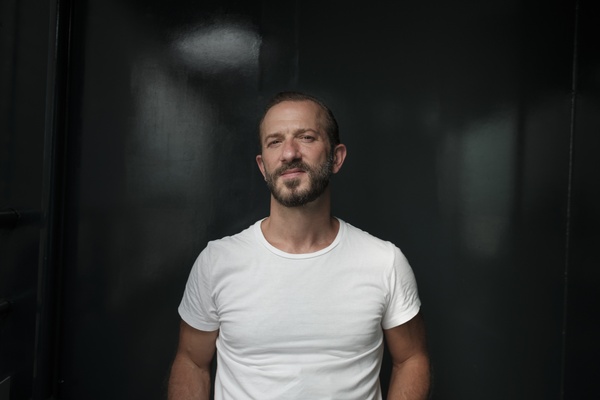Colin Stetson was born and raised in Ann Arbor, spent a decade in San Francisco and Brooklyn honing his formidable talents as a horn player, eventually settling in Montreal in 2007. Over the years he has worked extensively, live and in studio, with a wide range of bands and musicians including Tom Waits, Arcade Fire, Bon Iver, TV On The Radio, Feist, Laurie Anderson, Lou Reed, Bill Laswell, Evan Parker, The Chemical Brothers, Animal Collective, Hamid Drake, LCD Soundsystem, The National, Angelique Kidjo, Fink, and David Gilmore. Meanwhile, he has developed an utterly unique voice as a soloist, principally on saxophones and clarinets, his intense technical prowess matched by his exhilarating and emotionally gripping skills as a songwriter. Stetson's astounding physical engagement with his instruments (chiefly bass and alto saxophones) produces emotionally rich and polyphonic compositions that transcend expectations of what solo horn playing can sound like. Stemming from that approach and aesthetic, he has been contributing regularly to the world of film, TV, and game scoring over the past decade with such titles as Hereditary (2018), The First (2018), Red Dead Redemption 2 (2018), Color Out of Space (2019), Barkskins (2020), Mayday (2021), Among The Stars (2021), Texas Chainsaw Massacre (2022), The Menu (2022), and Uzumaki (2023).

|
|
|
|
|
|
|
|
|
|
|
|
2LP
|
|
MOVATM 378G-LP
|
Green color vinyl version. "Hereditary is a 2018 American psychological horror film written and directed by Ari Aster in his feature directorial debut. He later went on to direct Midsommar (2019) and Beau Is Afraid (2023). The movie stars Toni Collette, Alex Wolff, Milly Shapiro, Ann Dowd, and Gabriel Byrne. When Ellen, the matriarch of the Graham family, passes away, her daughter's family begins to unravel cryptic and increasingly terrifying secrets about their ancestry. The more they discover, the more they find themselves trying to outrun the sinister fate they seem to have inherited. The soundtrack for the movie was written, arranged, and produced by Colin Stetson. Aster tried to keep it simple for Stetson regarding the music, but he wanted one thing to be apparent: the music had to 'feel evil.' Stetson explained that he tried to look at the score as though it was a character in the film, the character of the unfolding narrative. With this score, he tried to avoid certain ubiquitous tropes found in film scoring and used sound sources to accomplish different ends. Stetson wanted that the music developed as the narrative progressed. Hereditary is available as a limited edition of 500 numbered copies on translucent green colored vinyl. This 2LP is housed in a gatefold sleeve that includes liner notes by the director, Ari Aster."
|
|
|
Artist |
Title |
Format |
Label |
Catalog # |
|
|
2LP
|
|
MOVATM 378Y-LP
|
Yellow color vinyl version. "Hereditary is a 2018 American psychological horror film written and directed by Ari Aster in his feature directorial debut. He later went on to direct Midsommar (2019) and Beau Is Afraid (2023). The movie stars Toni Collette, Alex Wolff, Milly Shapiro, Ann Dowd, and Gabriel Byrne. When Ellen, the matriarch of the Graham family, passes away, her daughter's family begins to unravel cryptic and increasingly terrifying secrets about their ancestry. The more they discover, the more they find themselves trying to outrun the sinister fate they seem to have inherited. The soundtrack for the movie was written, arranged, and produced by Colin Stetson. Aster tried to keep it simple for Stetson regarding the music, but he wanted one thing to be apparent: the music had to 'feel evil.' Stetson explained that he tried to look at the score as though it was a character in the film, the character of the unfolding narrative. With this score, he tried to avoid certain ubiquitous tropes found in film scoring and used sound sources to accomplish different ends. Stetson wanted that the music developed as the narrative progressed. Hereditary is available as a limited edition of 500 numbered copies on translucent green colored vinyl. This 2LP is housed in a gatefold sleeve that includes liner notes by the director, Ari Aster."
|
|
|
Artist |
Title |
Format |
Label |
Catalog # |
|
|
LP
|
|
RM 4155LP
|
A body is bounded. It operates within physical limitations and biological constraints. Whilst some see these physiological boundaries as a terminus, others such as Colin Stetson perceive them as a nexus of possibility, and perhaps even of expansion. It is in this zone of unsteady tension and promise that his new album Chimæra dwells. Collecting a series of extended drone works for saxophone, Chimæra charts an entirely new thread of work for Stetson. This thread simultaneously maintains states of reductive minimalism and reactive maximalism. The album pushes his physical abilities, as a body and also as a player to a new terrain. The pieces reveal his increasingly refined capacity to compose works that push out-ward testing for the boundaries of timbre, harmony and also density. Each of Chimæra's two pieces forge an almost geological sensibility, tracing out the imagined caverns, hidden hollows and surging magma flows of an underworld that exists beyond the everyday we know. His instrument breathes like wind expelled from lava pipes. The pieces are tactile, engulfing the entire body and the ears with equal ferocity. It is a record that melds together a deeply layered sense of sonic strata with an unwavering harmonic delicacy. For more than a decade now, Stetson has been involved an impressively divergent array of works that are concerned with the very physiology of sound. His lungs shaping sound through the coiling metallic pathways of his saxophones. This work is an opening to a new subterranean stream of his playing and resoundingly places him at the very center of an ever-expanding body of work that has come to define the potentials of his instrument of choice.
|
|
|
|